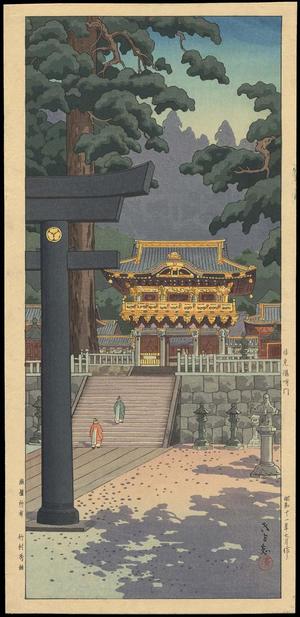Japanese Print "Nikko Yomeimon" by Tsuchiya Koitsu
Artist:Tsuchiya Koitsu
Title:Nikko Yomeimon
Date:1936
Details:More information...
Source:Japanese Art Open Database
Browse all 17,130 prints...
Description:
Sunday, 6 November 2005 This piece measures 7.25” x 15.25” and this is an original woodblock print titled the “Yomemimon Gate” featuring the main gate of Nikko Shinto Shrine. Nikko Toshogu Shrine is located in Tochigi Prefecture of Japan and the third Shogun Iyemitsu, the grandson of the first Shogun Tokugawa Ieyasu, built it. It is the mausoleum of Ieyasu who is one of the most important figures in Japanese history, the founder of the Tokugawa Shogunate that lasted for over 250 years until 1867. The Toshogu Shrine is very famous for its colorful and sumptuously decorated buildings that are unlike the typical simple styled built Shinto shrines. Yomeimon gate (Gate of Sunlight) is an incredibly ornate structure carved by some 130,000 craftsmen with an unlimited budget. Fearing the gods will be jealous of its beauty and the presumption of perfection, one of the gate’s columns was deliberately placed upside down. The construction exemplifies the highest development of applied arts of the Edo period (1603-1867) of Japanese history and the grandest example of Chinese influence in Japanese shrine architecture. The artist “Kiyoshi” had opted to place the ornate gate in the back but he was still able to draw ones attention to its gleaming gold decoration of the gate by contrasting with the dark Torii Shinto gate in the front. Since only half of the Torii gate is shown on the left shows that it is actually the background of this piece even though it is placed in the front so that the eyes are designed to focus on the Yomeimon gate. The two Shinto priests are approaching to the main gate among the deep trees emphasizing the quiet solitude. The writing on the side reads “Yomeimon Gate, July 1936” and the name of the artist is Kiyoshi, though his last name is unknown. The name of the publisher is shown on the left margin of the piece that reads “Takemura Hideo.” The condition of this piece is still very good though there is a wave indentation in the top right corner and rice glue mounting residue on the top two corners on the verso.
